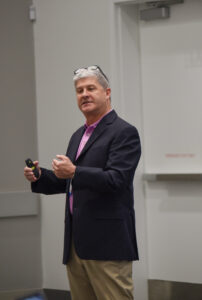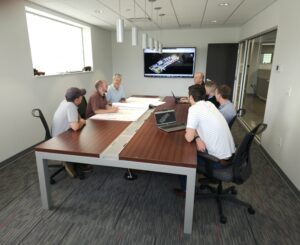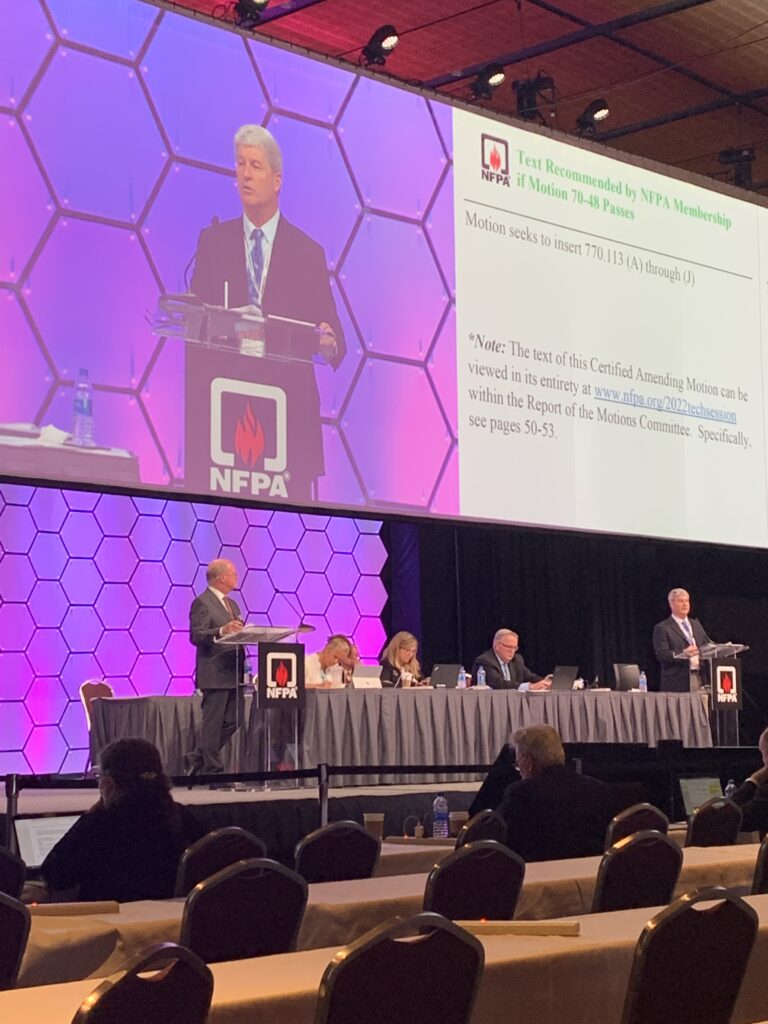IEC members are well aware of the important information contained in the 2023 NFPA 70® National Electrical Code®(NEC), as understanding and utilizing its instruction is key to effective and safe day-to-day work throughout electrical contracting.
One person you can thank for its comprehensive approach is IEC contractor member and 2023 IEC Codes & Standards Committee Chair Larry Ayer. In addition to overseeing the code’s accuracy, Larry is committed to ensuring it is relevant for years to come. Active within National Fire Protection Association (NFPA) for nearly 20 years and currently serving as chair of the NFPA Correlating Committee, Larry is positioned to achieve that goal.
“The NFPA Correlating Committee oversees nine electrical standards within their purview,” Larry explains. “There are more than 300 standards that NFPA creates and publishes, and the NEC® would be considered the flagship standard or code for the organization.”
The NEC® consists of 18 code-making panels. The NFPA Correlating Committee’s main role is to not only oversee consistency throughout the document but to provide the long-term vision for success.
Larry’s Route to the Role
 An engineer by trade, Larry is vice president of Biz Com Electric in Cincinnati, OH, a firm incorporated in 1984 to sell phone systems or business communications. The firm quickly expanded into telecommunications cabling as well as electrical contracting services. Larry joined Biz Com in the early 1990s. In 1996, he started another firm, E2M Engineering, to provide electrical and mechanical consulting engineering services.
An engineer by trade, Larry is vice president of Biz Com Electric in Cincinnati, OH, a firm incorporated in 1984 to sell phone systems or business communications. The firm quickly expanded into telecommunications cabling as well as electrical contracting services. Larry joined Biz Com in the early 1990s. In 1996, he started another firm, E2M Engineering, to provide electrical and mechanical consulting engineering services.
“I know the engineering part and I know the contracting part, so that I think that helps me be a better overall contractor and engineer,” Larry says.
It also helps him understand how various professionals utilize the code book. He began his journey with the NFPA in 2004, when IEC of Greater Cincinnati colleague and friend David Hittinger encouraged him to serve on an NFPA Technical Committee. David is IEC director of codes, standards, and safety.
“I always thought it would be interesting to be involved in these committees,” Larry says. “Doing so has helped me to understand more about the inner workings and process of how standards are set for the country. I have learned a tremendous amount; it’s basically the best seminar you can go to! You learn from national leaders and you form a network of people who you can call with questions and know you will find the answers.”
Larry says David has been a great mentor to him and when an opening arose on the NFPA Correlating Committee, David asked him if he was interested in the position.
Larry’s Nine-Year Plan
With technical committee experience behind him, incredible volunteers beside him, and a vision for the future of the NEC®, Larry got to work promoting a nine-year-plan that both ensures the continued accuracy of the NEC®, as well as an action plan that provides a pathway for improvement.
“The NEC® has been around for more than 125 years,” Larry says. “And like anything else in life, things have changed. But the NEC® has been roughly the same format since 1937. People learn differently today, new technologies are developed, utilities have been deregulated, and homeowners have solar panels with storage batteries as well as electric vehicles that can actually power a home for a day and a half.”
When Larry became Correlating Committee chair about three years ago, his nine-year plan included three areas that needed improvement: medium voltage, limited energy / communications, and alternative energy. The plan has evolved and through lots of hard work and consensus building, these topics have emerged as focus areas.
“For the 2023 cycle, we looked at medium voltage and we improved that,” Larry reports. “For 2026, we’re looking to improve the limited energy or communications piece of the NEC®. And for 2029, we’re looking to restructure the NEC® to maintain relevance for years to come.”
Major Wins

Larry points to the 2020 reduction in lighting requirements in the way you size the space as you come into a building. The lighting requirements were reduced by 60 percent in certain occupancies. Another change resulting in major cost savings for electrical contractors was reducing the size for conductors on rooftops. These are examples of important updates written into the code to keep up with the times he says.
By and far, however, Larry feels his group’s biggest win is obtaining buy-in to be able to make significant changes in how the book is structured.
“When I first started on the Correlating Committee, I suggested that maybe we should add a chapter or two to better organize things and make it more user friendly,” Larry says. “You would have thought I killed somebody based on how upset some people got over this suggestion. People were more comfortable finding a place to throw the new technologies or topics into the existing eight chapters. The code book was never able to expand.”
Fast forward a couple of years. The Correlating Committee has laid out a framework and presented it to numerous organizations for feedback. Their goal over the next couple of years is to make sure they have that framework right and to make these organizational changes in the 2029 NEC® book.
“We typically meet every two weeks for a couple of hours on this ongoing project,” he says. “We assess what we still need to do, identify gaps, and adjust as appropriate.”
One example of how topics might be better organized is one of the new chapters being proposed — Installations Associated with Bodies of Water. The framework shows three sections in this chapter: Swimming Pools, Fountains, and Similar Installations; Natural and Artificially Made Bodies of Water; and Marinas, Boatyards, Floating Buildings, and Commercial and Noncommercial Docking Facilities. Currently, Larry says, these sections reside in different chapters of the code book.
In April 2023, the Correlating Committee released a white paper, Keeping the NEC® Relevant – Is Now the Time to Modernize?, outlining reasons for a revised organizational structure. Acknowledging the book’s “critical role for personnel in learning, understanding, applying, and enforcing the requirement established within the regulatory code,” it points to much-needed modernization to support “advancing electrical infrastructure configurations and technological advancements.” An excerpt from the white paper:
Industry Trends
Historically, the NEC was written based on a serving utility providing electricity to premises with conductors, overcurrent devices, and loads. While this theme has held true for a majority of the NEC’s lifespan, technology changes over the past two decades have challenged this theme. New and evolving technologies along with novel concepts have been “force fit” into the existing structure due to the structural constraints that impact overall usability. Many other industry trends are also challenging the existing structural model:
- Communication systems in Chapter 8 are no longer installed or maintained by communication utilities.
- Electrical Systems over 1000V AC / 1500V DC (Medium Voltage) has expanded well beyond utility ownership.
- Limited energy systems in Chapter 7 and 8 are commonplace (no longer “special”) and are morphing into systems that mimic Chapter 3 wiring methods.
- Distributed Energy Resource technologies are challenging the status of single direction power flow and connection to premises or to the utility.
- DC circuits and advanced electrical storage technologies are increasing in use.
- Energy monitoring, control and automation are accelerating energy resilience, such as microgrids, energy efficiency, and alternate power sources.
- Enforcement of the NEC is conducted by many disciplines that can include electrical inspectors, consulting engineers, building officials and fire officials.
These trends and others require that we look to challenge the status quo and look to a more robust layout that will enhance the stability and usability for the next several decades and beyond.
“Trying to change the way people think is a challenge in any organization, and especially in one as big as the electrical industry,” Larry summarizes. “It takes some time to get people to truly think about what you’re proposing. As long as you communicate a clear and consistent message, I think you can eventually win it.”
Next Steps
Larry encourages all IEC contractors to become involved in the codes and standards process, for their own personal career growth as well as for the good of the industry. You can start by reviewing the white paper and proposed framework. There are numerous ways to participate.
2026 NEC® Input Phase
Following publication of the current 2023 NEC® edition, NFPA accepts input from the public for consideration in the first draft of the next edition. The public input phase for NEC® 2026 closes September 7, 2023. Submit input here.
Attend 2023 IEC Codes & Standards Safety Summit
This annual IEC event is dedicated to helping people understand the NEC® and safety related content — especially the technical aspects of the electrical construction industry — and how to be a better electrical contractor through the regulatory environment. The Summit is set for August 7-9, 2023, in Houston, TX.
Join a Committee
Larry invites contractors to serve on the Codes & Standards Committee. In addition to providing much-needed hands and minds to IEC efforts, this is a great pathway to being asked to represent IEC on NFPA technical committees. He points to better understanding the NEC® yourself, broadening your wealth of knowledge in the electrical industry, networking with national leaders, and meeting manufacturers and others that are very close to product development and safety as benefits to becoming involved.
“You’re at the forefront of what’s happening in the electrical industry, so you’re more apt to know what’s going on in the development process,” he adds. “You’ll understand which way the industry is heading.”
 The National Electrical Code® (NEC) is one of the most widely used and recognized consensus standards in the world today. The NEC is updated and revised every three years to reflect current trends in the electrical Industry. Representatives from throughout the electrical industry contribute to the development of the Code representing applied research/testing laboratories, installer/maintainer, labor, users, manufacturing, electrical utilities, enforcing authority, insurance, consumer, and special expert. IEC technical committee members participate on all 18 code-making panels representing our interest in the electrical construction industry.
The National Electrical Code® (NEC) is one of the most widely used and recognized consensus standards in the world today. The NEC is updated and revised every three years to reflect current trends in the electrical Industry. Representatives from throughout the electrical industry contribute to the development of the Code representing applied research/testing laboratories, installer/maintainer, labor, users, manufacturing, electrical utilities, enforcing authority, insurance, consumer, and special expert. IEC technical committee members participate on all 18 code-making panels representing our interest in the electrical construction industry.
The NEC® is a legal document designed to be adopted by local and/or state government bodies. Local jurisdictions may choose to adopt the code in its entirety, or modify specific additions or exceptions.


